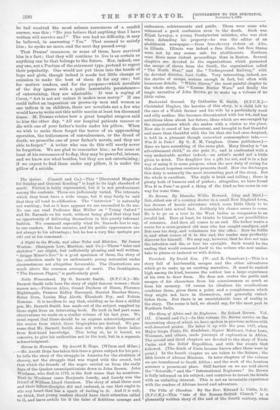Heroes in Homespun. By Aseott R. Hope. (Wilson and Milne.)
—Mr. Ascott Hope has taken this time a grave subject for his pen ; he tells the story of the struggle in America for the abolition of slavery, not the struggle that was waged with the sword, but that which the friends of the negro carried on from the early days of the Quaker emancipationists down to John Brown. John Woolman, who died in 1772, is the first name that he mentions. Next to Woolman came Benjamin Lundy, and Lundy was the friend of William Lloyd Garrison. The story of what these men and their fellow-disciples did and endured, is one that ought to stir any heart that has a spark of feeling in it. And it is well, we think, that young readers should have their attention called to it, and leave awhile for it the tales of fictitious courage and
endurance, achievements and perils. There were some who witnessed a good confession even to the death. Such was Elijah Lovejoy, a young Presbyterian minister, who was shot when defending his property—he was the editor of an abolitionist newspaper —from free-slavery rioters at Alta, in Illinois. Illinois was indeed a free State, but free States were not by any means safe for abolitionists. Nowhere were there more violent proceedings than in Boston. Several chapters are devoted to the organisations which promoted the escape of slaves from the South, the organisation called "The North Star," and the "Underground Railway," with its devoted director, Levi Coffin. Very interesting, indeed, are the stories of escape, serious enough in fact, but often with humorous details. "White Slaves," the most painful chapter in the whole story, the "Kansas Border Wars," and finally the tragic narrative of John Brown, go to make up a volume of no little value.


















































 Previous page
Previous page